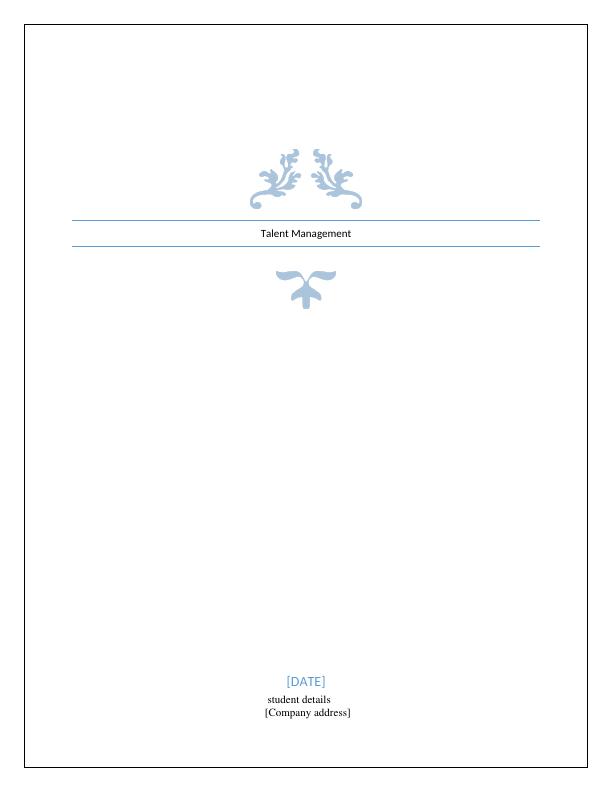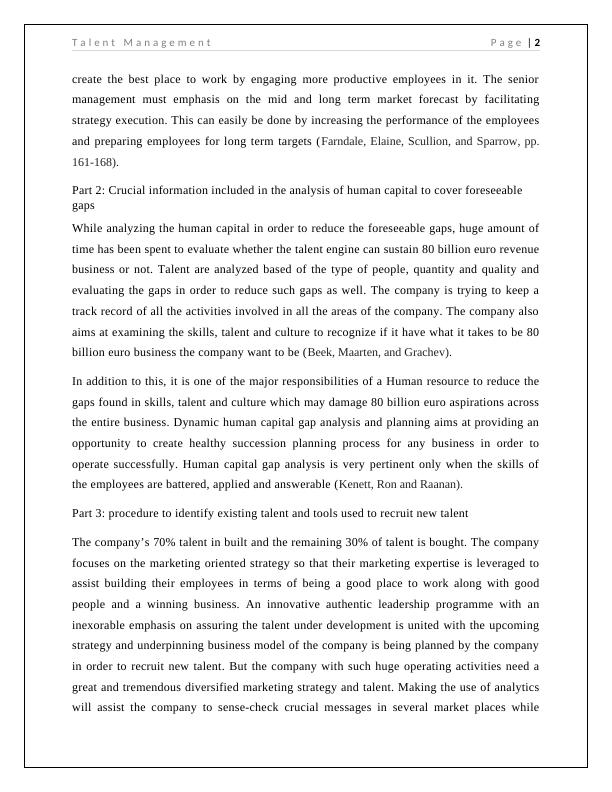Talent Management: Unilever's HR Vision, Market Forecast, Human Capital Analysis, Leadership Attributes, and Recruitment Approach
Added on 2023-06-11
9 Pages2751 Words351 Views
Talent Management
[DATE]
[DATE]

T a l e n t M a n a g e m e n t P a g e | 1
Task 1: How Unilever People Place and Performance HR vision works
Unilever aims at creating a platform and culture where their employees are endowed at act
like entrepreneurs and business owners. The analytical approach adopted by the company
has assisted it to reach the new and innovative level of transparency both internally as well
as externally on all the levels i.e. corporate level and people based level. Regarding to
corporate paybacks, Unilever has been unambiguous in stating its major targets in the public
then reporting grip against them (Cavusgil, Tamer, Pervez, Ghauri, and Akcal).
There are three major goals of the Unilever Sustainable Living plan i.e. to enhance the
health and wellbeing of the customers and its employees, decrease the impact of
environmental issues and uplift livelihoods. Assisting all the goals helps in better
performance of social, environmental and economic issues across the entire value chain.
Unilever also aims at adopting talent strategy which integrate the compass strategy as well.
Maintaining people, place and performance is one of the challenge which aims at how to
protect the best talent, how to provide best work place and how to make people perform best
to gain productive outcomes. Unilever has successfully accepted the three fold challenge
and created platform which will best satisfy the company as well as its potential customers
(Grant and Robert).
Task 2:
Part 1: Importance to focus on mid and long term market forecast and HR needs
It is very crucial for senior management, including HR management, to focus on mid and
long-term market forecasts and human resource needs because of the painful boom-and-bust
cycle of the budget cuts and rapid growth. The boom and bust phases are really complex
phase to manage because it all depends on analyzing and evaluating the market in a more
precise form (Chakravarthy, Bala, and Coughlan).
Managing the needs of HR is not as simple as it seems to be. It is all about adding
supplementary value to the company. Analyzing the needs of HR helps to improve the
productivity in an organization by recruiting potential candidates who can generate benefits
to the company and get the vision and mission achieved. In addition to this, it also helps to
reduce the unnecessary costs incurred by the company. Moreover, it build up the brand and
Task 1: How Unilever People Place and Performance HR vision works
Unilever aims at creating a platform and culture where their employees are endowed at act
like entrepreneurs and business owners. The analytical approach adopted by the company
has assisted it to reach the new and innovative level of transparency both internally as well
as externally on all the levels i.e. corporate level and people based level. Regarding to
corporate paybacks, Unilever has been unambiguous in stating its major targets in the public
then reporting grip against them (Cavusgil, Tamer, Pervez, Ghauri, and Akcal).
There are three major goals of the Unilever Sustainable Living plan i.e. to enhance the
health and wellbeing of the customers and its employees, decrease the impact of
environmental issues and uplift livelihoods. Assisting all the goals helps in better
performance of social, environmental and economic issues across the entire value chain.
Unilever also aims at adopting talent strategy which integrate the compass strategy as well.
Maintaining people, place and performance is one of the challenge which aims at how to
protect the best talent, how to provide best work place and how to make people perform best
to gain productive outcomes. Unilever has successfully accepted the three fold challenge
and created platform which will best satisfy the company as well as its potential customers
(Grant and Robert).
Task 2:
Part 1: Importance to focus on mid and long term market forecast and HR needs
It is very crucial for senior management, including HR management, to focus on mid and
long-term market forecasts and human resource needs because of the painful boom-and-bust
cycle of the budget cuts and rapid growth. The boom and bust phases are really complex
phase to manage because it all depends on analyzing and evaluating the market in a more
precise form (Chakravarthy, Bala, and Coughlan).
Managing the needs of HR is not as simple as it seems to be. It is all about adding
supplementary value to the company. Analyzing the needs of HR helps to improve the
productivity in an organization by recruiting potential candidates who can generate benefits
to the company and get the vision and mission achieved. In addition to this, it also helps to
reduce the unnecessary costs incurred by the company. Moreover, it build up the brand and

T a l e n t M a n a g e m e n t P a g e | 2
create the best place to work by engaging more productive employees in it. The senior
management must emphasis on the mid and long term market forecast by facilitating
strategy execution. This can easily be done by increasing the performance of the employees
and preparing employees for long term targets (Farndale, Elaine, Scullion, and Sparrow, pp.
161-168).
Part 2: Crucial information included in the analysis of human capital to cover foreseeable
gaps
While analyzing the human capital in order to reduce the foreseeable gaps, huge amount of
time has been spent to evaluate whether the talent engine can sustain 80 billion euro revenue
business or not. Talent are analyzed based of the type of people, quantity and quality and
evaluating the gaps in order to reduce such gaps as well. The company is trying to keep a
track record of all the activities involved in all the areas of the company. The company also
aims at examining the skills, talent and culture to recognize if it have what it takes to be 80
billion euro business the company want to be (Beek, Maarten, and Grachev).
In addition to this, it is one of the major responsibilities of a Human resource to reduce the
gaps found in skills, talent and culture which may damage 80 billion euro aspirations across
the entire business. Dynamic human capital gap analysis and planning aims at providing an
opportunity to create healthy succession planning process for any business in order to
operate successfully. Human capital gap analysis is very pertinent only when the skills of
the employees are battered, applied and answerable (Kenett, Ron and Raanan).
Part 3: procedure to identify existing talent and tools used to recruit new talent
The company’s 70% talent in built and the remaining 30% of talent is bought. The company
focuses on the marketing oriented strategy so that their marketing expertise is leveraged to
assist building their employees in terms of being a good place to work along with good
people and a winning business. An innovative authentic leadership programme with an
inexorable emphasis on assuring the talent under development is united with the upcoming
strategy and underpinning business model of the company is being planned by the company
in order to recruit new talent. But the company with such huge operating activities need a
great and tremendous diversified marketing strategy and talent. Making the use of analytics
will assist the company to sense-check crucial messages in several market places while
create the best place to work by engaging more productive employees in it. The senior
management must emphasis on the mid and long term market forecast by facilitating
strategy execution. This can easily be done by increasing the performance of the employees
and preparing employees for long term targets (Farndale, Elaine, Scullion, and Sparrow, pp.
161-168).
Part 2: Crucial information included in the analysis of human capital to cover foreseeable
gaps
While analyzing the human capital in order to reduce the foreseeable gaps, huge amount of
time has been spent to evaluate whether the talent engine can sustain 80 billion euro revenue
business or not. Talent are analyzed based of the type of people, quantity and quality and
evaluating the gaps in order to reduce such gaps as well. The company is trying to keep a
track record of all the activities involved in all the areas of the company. The company also
aims at examining the skills, talent and culture to recognize if it have what it takes to be 80
billion euro business the company want to be (Beek, Maarten, and Grachev).
In addition to this, it is one of the major responsibilities of a Human resource to reduce the
gaps found in skills, talent and culture which may damage 80 billion euro aspirations across
the entire business. Dynamic human capital gap analysis and planning aims at providing an
opportunity to create healthy succession planning process for any business in order to
operate successfully. Human capital gap analysis is very pertinent only when the skills of
the employees are battered, applied and answerable (Kenett, Ron and Raanan).
Part 3: procedure to identify existing talent and tools used to recruit new talent
The company’s 70% talent in built and the remaining 30% of talent is bought. The company
focuses on the marketing oriented strategy so that their marketing expertise is leveraged to
assist building their employees in terms of being a good place to work along with good
people and a winning business. An innovative authentic leadership programme with an
inexorable emphasis on assuring the talent under development is united with the upcoming
strategy and underpinning business model of the company is being planned by the company
in order to recruit new talent. But the company with such huge operating activities need a
great and tremendous diversified marketing strategy and talent. Making the use of analytics
will assist the company to sense-check crucial messages in several market places while

End of preview
Want to access all the pages? Upload your documents or become a member.
Related Documents
Talent Management at Unilever: Strategies and Approacheslg...
|9
|1676
|260
Talent Management at Unilever: Strategies and Approacheslg...
|9
|1904
|325
International HRM- The three most important HR practices for an International businesslg...
|12
|1510
|244
International Resourcing and Planninglg...
|8
|2145
|70
Human Resource Proposal: HR Planning, Methodology and Talent Developmentlg...
|12
|3611
|159
Resource and Talent Planninglg...
|15
|4879
|1